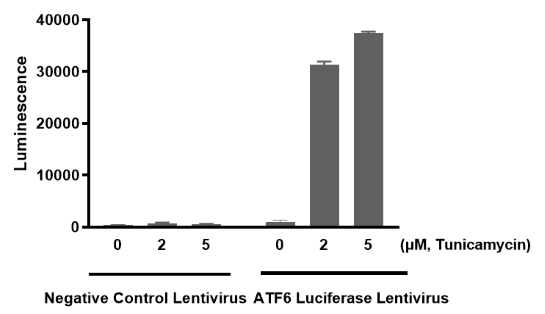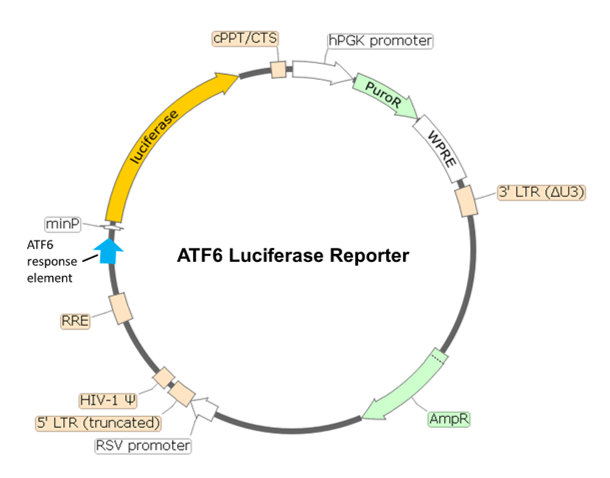78667
ATF6 Luciferase Reporter Lentivirus (ATF6 Pathway)
BPS Bioscience
DESCRIPTION
The ATF6 (Activating Transcription Factor 6) Luciferase Reporter Lentiviruses are replication incompetent, HIV-based, VSV-G pseudotyped lentiviral particles ready to transduce most types of mammalian cells, including primary and non-dividing cells. These viruses transduce cells with the firefly luciferase gene driven by multiple copies of an ATF6 response element, located upstream of the minimal TATA promoter. The lentiviruses also transduce a puromycin selection gene (Figure 1). After transduction, the ATF6-mediated response to ER (endoplasmic reticulum) stress can be monitored by measuring luciferase activity.
DETAILS
- Notes: To generate ATF6 luciferase reporter stable cells, remove the growth medium 48 hours after transduction and replace it with fresh growth medium containing the appropriate amount of puromycin, for antibiotic selection of transduced cells. The following Lentivirus Reporter Controls are available from BPS Bioscience to meet your experimental needs: Negative Control Luciferase Lentivirus (BPS Bioscience #79578): Ready-to-transduce lentiviral particles expressing firefly luciferase under the control of a minimal promoter. This negative control is important to establish the specificity of any treatments and to determine background reporter activity. Renilla Luciferase Lentivirus (BPS Bioscience #79565): Ready-to-transduce lentiviral particles expressing Renilla luciferase under the CMV promoter. The Renilla luciferase lentivirus can serve as an internal control to overcome sample-to-sample variability when performing dual-luciferase reporter assays. Firefly Luciferase Lentivirus (BPS Bioscience #79692-G, #79692-H, #79692-P): Ready-to-transduce lentiviral particles expressing firefly luciferase under the CMV promoter. It serves as a positive control for transduction optimization studies. Biosafety: The lentiviruses are produced with SIN (self-inactivation) lentivector which ensures self-inactivation of the lentiviral construct after transduction and integration into the genomic DNA of the target cells. None of the HIV genes (gag, pol, rev) will be expressed in the transduced cells, as they are expressed from packaging plasmids lacking the packing signal and are not present in the lentivirus particle. Although the pseudotyped lentiviruses are replication-incompetent, they require the use of a Biosafety Level 2 facility. BPS Bioscience recommends following all local federal, state, and institutional regulations and using all appropriate safety precautions. Troubleshooting Guide: Visit bpsbioscience.com/lentivirus-faq for detailed troubleshooting instructions. For all further questions, please email support@bpsbioscience.com.
- Shiptemp: -80°C (dry ice)
- Warnings: Avoid freeze/thaw cycles
- Category: Oxidative Stress/Lentivirus
- Background: Activating Transcription Factor 6 (ATF6) is a transmembrane transcription factor that responds to endoplasmic reticulum (ER) stress via the unfolded protein response (UPR). In the presence of excess misfolded proteins, the UPR is activated and there is an increase in chaperone expression. ATF6 is one of the three critical proteins of the UPR. In response to ER stress, ATF6 is cleaved, and the cytosolic portion is translocated to the nucleus where it binds to ER stress-response elements on the promoters of target genes, leading to transcription of ER molecular chaperones. Dysfunction in the UPR pathway results in developmental defects, neurodegenerative diseases, and cancer. Strategies targeting ATF6 may prove beneficial for cancer and degenerative disease treatment.
- Description: The ATF6 (Activating Transcription Factor 6) Luciferase Reporter Lentiviruses are replication incompetent, HIV-based, VSV-G pseudotyped lentiviral particles ready to transduce most types of mammalian cells, including primary and non-dividing cells. These viruses transduce cells with the firefly luciferase gene driven by multiple copies of an ATF6 response element, located upstream of the minimal TATA promoter. The lentiviruses also transduce a puromycin selection gene (Figure 1). After transduction, the ATF6-mediated response to ER (endoplasmic reticulum) stress can be monitored by measuring luciferase activity.
- Formulation: The lentiviruses were produced in HEK293T cells in medium containing 90% DMEM + 10% FBS. Virus particles can be packaged in custom formulations by special request, for an additional fee.
- Supplied As: Two vials (500 µl x 2) of lentivirus at a titer >107 TU/ml. The titer will vary with each lot; the exact value is provided with each shipment.
- Unspsc Code: 41106621
- Unspsc Name: Virus mediated expression vectors or kits
- Applications: • Expression of ATF6-dependent luciferase reporter to study the ATF6 response • Generate ATF6 luciferase reporter stable cell lines (puromycin resistant).
- Product Type: Lentivirus
- Biosafety Level: BSL-2
- Related Products: 79578, 79565, 79692
- Storage Stability: Lentiviruses are shipped with dry ice. For long-term storage, it is recommended to store the lentiviruses at -80°C. Avoid repeated freeze-thaw cycles. Titers can drop significantly with each freeze-thaw cycle.
- Scientific Category: Immunotherapy, Cell Signaling Pathway

